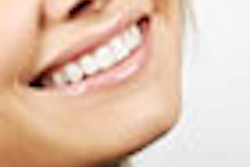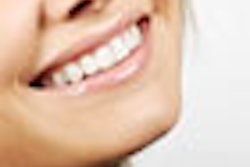
A pearly white smile is always in high demand. But can using too much hydrogen peroxide for whitening permanently damage tooth enamel in the process?
Apparently not, according to a study published in this month's Journal of the American Dental Association (April 2010, Vol. 141:4, pp. 449-454).
Researchers from the University of Trieste found that using a 38% hydrogen peroxide in-office whitening agent does not alter enamel surface roughness, even after multiple applications.
Some in vitro studies have shown that the use of high-concentration hydrogen peroxide-based products can cause alteration of the enamel surface characterized by increased porosity of the superficial enamel structure, demineralization, calcium loss, etc., the study authors noted.
"We conducted this study to test one of the professional whitening systems with the highest hydrogen peroxide concentration, thus potentially harmful to tooth tissues," stated lead author Milena Cadenaro, D.D.S., Ph.D., an associate professor at the University of Trieste, in an e-mail to DrBicuspid.com.
Study findings
The study authors looked at 20 patients (8 men and 12 women; age range of 22 to 43 years) who were willing to receive tooth bleaching. All participants had anterior teeth of shade A3 or darker, as determined by using the Vita classic shade guide (Vident).
“We conducted this study to test one of the professional whitening systems with the highest hydrogen peroxide concentration.”
— Milena Cadenaro, D.D.S., Ph.D.
Participants underwent a professional prophylaxis one week before beginning the study. They also received oral hygiene instructions to brush their teeth twice a day with a low-abrasion toothpaste and floss at least once a day.
Researchers used a 38% hydrogen peroxide bleaching agent (Opalescence Boost PF, Ultradent) to perform the bleaching treatment four times at one-week intervals. Each treatment was done under rubber dam isolation.
The researchers then performed profilometric and scanning electron microscopic (SEM) analyses of epoxy resin replicas of the upper right incisors at baseline and after each bleaching treatment.
For each specimen, they evaluated the following roughness parameters in micrometers: roughness average, maximum profile peak height, maximum profile valley depth, and surface skewness.
The profilometric analysis of the enamel surface replicas after bleaching showed no significant difference in surface roughness compared with baseline, irrespective of the time interval. Results of the correlated SEM analysis also showed no relevant alteration on the enamel surface.
"The results of our in vivo study indicate that in-office bleaching with Opalescence Boost PF, applied once per week for four weeks, did not produce significant alterations in enamel surface roughness," the authors wrote. "This would indicate that the appropriate use of high-concentration bleaching products has no harmful effects on enamel surface micromorphology."
In vitro vs. in vivo findings
What makes this research unique is that it investigates the effects of the tested bleaching agent on enamel in vivo, while the majority of studies on this topic have been conducted in vitro, Dr. Cadenaro told DrBicuspid.com.
The in vitro studies frequently led to inconsistent results. Moreover, in vitro alterations might not correspond with alterations observed in vivo, the authors noted. The main advantage of this study was the evaluation of the effects of the tested bleaching agent on enamel surface in a normal intraoral environment, they added.
"The results of the study are not surprising and could have been expected considering previous investigations, but the fact that they were obtained under relevant clinical conditions gives particular strength to the observed outcomes that can be applied to everyday practice," Dr. Cadenaro told DrBicuspid.com.
Sias Grobler, D.Sc., Ph.D., director of the Oral and Dental Research Institute at the University of the Western Cape, has done similar research on the same product and came to similar conclusions (Journal of the South African Dental Association, November 2009, Vol. 64:10, pp. 474-479).
Grobler and colleagues evaluated the effect of various teeth-whitening products containing carbamide peroxide (CP) and hydrogen peroxide (HP) on enamel microhardness. They found that all products tested in this study decreased enamel microhardness except Opalescence Boost 38% HP, noting that the products containing carbamide peroxide were more damaging to enamel because of the longer application times.
"The results of our research, done on the same product but through microhardness tests of enamel, support the finding of these authors on this specific product," Grobler told DrBicuspid.com.
However, Michel Goldberg, D.D.Sc., professor emeritus at the University of Paris V, has also published a review on this topic (Clinical Oral Investigations, February 2010, Vol.14:1, pp. 1-10) and came to a different conclusion.
"Local effects may occur on the oral mucosa and dental tissues during whitening, namely, pulp sensitivity, cervical resorption, release of selected components of dental restorative materials, and alteration of the enamel surface," Dr. Goldberg and colleagues noted in their review.
Maybe the fact that Dr. Cadanero and her colleagues found no effect on enamel depends on the formulation, she told DrBicuspid.com.
"In our in vitro experiments, application of hydrogen peroxide induced enamel alterations, not as much as etching with an acid gel, but volcano craters, loss of crystallites, and a rough surface," Dr. Goldberg concluded.
Copyright © 2010 DrBicuspid.com



















